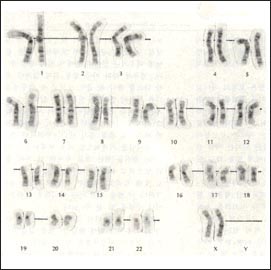
Copyright ⓒ 2014 John Sangwon Lee, MD., FAAP
Gender and inheritance of fetus 태아의 성별과 유전

Female chromosome During pregnancy, the sex of the fetus can be determined by using an X-ray photograph, an ultra photographic examination, and an amniotic fluid chromosome examination.
![]()
One egg and one sperm meet to be fertilized, and then a fertilized egg is formed. From that moment on, the gender of the fetus is decided.
From that moment on, the color of the fetus’s hair, eye color, and skin color are determined according to the genetic factor blueprint.
The baby will have the genes of the mother who gave the eggs and the genes of the father who gave the sperm.
The 8-week-old fetus has an external genitalia shape, but it is difficult to clearly distinguish between male and female sex.
After that, the external genital morphology is developed so that the sex of the fetus can only be discriminated at around 16 weeks of pregnancy using the fetal ultrasound picture. However, at this time, the fetal’s cell chromosome must be tested in amniotic fluid to determine the fetal’s sex.
An amniotic fluid test is called an amniotic fluid test by pricking the abdominal wall, uterine wall, and amniotic membrane of a pregnant woman with an injection needle and pulling out amniotic fluid in the amniotic sac and performing various tests with the cells in the amniotic fluid.
Fetal sex tests with amniotic fluid are rarely done these days because there is a small possibility that there is a risk to the pregnant woman and the fetus when the amniotic fluid is drawn. Instead, a fetal ultra-sound test is usually done only when needed. It is possible to understand the feelings of parents who want to know the sex of the fetus before birth, but it is necessary to carefully consider performing an amniotic fluid test to simply determine the sex of the fetus.
Nowadays, when a regular fetal ultrasound test is routine, almost 100% of the sex of the fetus can be determined before birth.
However, without such a test, the probability that the fetus in the womb is a male fetus is 50% and the probability of a female fetus is 50%, without any tests. Copyright ⓒ 2014 John Sangwon Lee, MD., FAAP
“부모도 반의사가 되어야 한다”-본 사이트의 내용은 여러분들의 의사로부터 얻은 정보와 진료를 대신할 수 없습니다.
“The information contained in this publication should not be used as a substitute for the medical care and advice of your doctor. There may be variations in treatment that your doctor may recommend based on individual facts and circumstances.
“Parental education is the best medicine.“